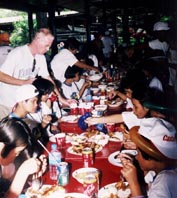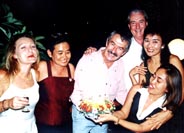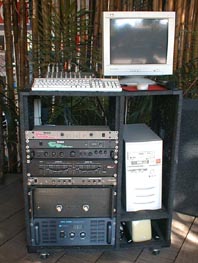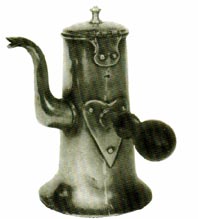















|
Pattaya’s Rotary Week extends to Royal Varuna YC
Story and photos by Peter Cummins
Each year for the past four years, Rotary Bangkok South has taken disadvantaged children from their Pakkred foster home, some 15 kilometers outside Bangkok,
and escorted the little ones to the Royal Varuna Yacht Club at South Pattaya, for a day of fun and feasting at the seaside.
 President Erika: what a pretty
waitress for the children! President Erika: what a pretty
waitress for the children!
The timing of this year’s “Kids Out” programme was most appropriate, for it came right after “Rotary Week in Pattaya”, held at the Amari Orchid
Resort from 16 to 24 March. The Rotary Fair, as it was popularly known, brought health and dental checks to disadvantaged children, environmental clean-up sessions, road-safety
and anti-drug programmes and other examples of Rotary International’s dedication to humanitarian causes everywhere.
This year, the fifth “Kids Out” picnic was the largest and, by all accounts, the most successful to date, with more than 300 children and 100 Rotarians
from the Bangkok South and the Pattaya-Jomtien Clubs descending on Royal Varuna in a convoy of 12 buses.
On arrival at the Varuna foreshore, they played in the sea and in the club swimming pool, felt the caress of the warm south wind on their faces - many, for
the first time - and enjoyed life like any child, anywhere - if only for a day.
 Rotary Bangkok South’s Sean Brady
weighs in with the service Rotary Bangkok South’s Sean Brady
weighs in with the service
Rotarians were out in full force, also, to help the youngsters enjoy their special day, serving them food, drinks and, of course, an unlimited supply of ice
cream which they relished (so did a few of the Rotarians!).
The incomparable “Dr Penguin” and his “fall guy” Eddie were there with a thousand tricks which enthralled the youngsters - and quite a few of the
adults as well, it is worth adding! The Royal Varuna veranda was a sea of Castrol “Kids Out” tee shirts, red caps and happy, grinning faces, as Dr Penguin and Eddie went
through their hilarious routines.
 Walter Meyer extends his hand of
friendship to the children Walter Meyer extends his hand of
friendship to the children
Jomtien-Pattaya Rotarians, led by President Erika Keller and ably assisted by David Jeater, catered to the children’s every need, while George and Margaret
Tomlinson continued their sterling work out on the sea, ferrying the youngsters around. It was, in fact, wall-to-wall Rotarians - at the dining tables, at the pool, on the
lawns and on the beach - ensuring that their young charges had the most possible enjoyment from their day out.
Finally, it was time to head for the buses waiting outside the Varuna gates. As the army of brave, cheerful little people was wheeled, lifted, carried or
managed to hobble to the exit, there was a farewell package for each one, the customary cookies from Walter Meyer, to ease the way back to Pakkred, the only home they have ever
known.
 Bangkok South Rotarians all Bangkok South Rotarians all
There were many moist eyes on the little - and not just a few of the big people. As the buses pulled away, it was difficult not to reflect on the vagaries of
life: the innocence of the Pakkred children who have been dealt a bad hand, but whose minds radiate an inner beauty which we, the able-bodied, would do well to emulate.
They will be back again next March for the 2002 “Kids Out” - the day at the seaside which brings light and hope into their lives limited by their
physical disabilities - if only for a day.
A fond farewell to Danish friends
Last week the Captain’s Corner held a farewell cocktail party for two delightful Danish visitors. What makes these rather beautiful ladies unique is they
are just about to return home after two months spent volunteering at the Pattaya orphanage.
 Unithai men Philip, Ty, Kevin,
Dave and Jim have plenty of reason to celebrate their own achievements Unithai men Philip, Ty, Kevin,
Dave and Jim have plenty of reason to celebrate their own achievements
Anja Beyer and Susanne Olsen have been friends for twenty years. Anja has just taken a year’s leave from teaching school and Susanne from an advertising
agency. Both of them were leaving with mixed feelings and wanting to return.
 Harpic, Aoy Tennische, Peter
Cummins, Doctor Iain, Rattana and Kanika enjoy another PC Birthday celebration. Harpic, Aoy Tennische, Peter
Cummins, Doctor Iain, Rattana and Kanika enjoy another PC Birthday celebration.
Anja said, “It’s one of the best things I’ve ever done. You give a little and you get a little. The kids give you kisses and hugs and you can just
show them that you are there for them. It made me very happy and content but it is overwhelming too. I am a teacher and am used to working with children and saying goodbye
but I guess I became more emotionally involved than I thought I would. Now I am feeling sad because I am leaving but I will come back again. I am going to resign from my job
at home so I can do this more often.”
 Hanne Kops, Kanika, Susanna and
Mr Badminton himself, Alan Kops Hanne Kops, Kanika, Susanna and
Mr Badminton himself, Alan Kops
Susanne reiterated Anja sentiments, “You really get your feelings turned on here. I truly appreciate the way the Thai people are always happy about life
and full of hope in spite of often being very poor. This is not so in Denmark where people are more materialistic. Thais have a great natural optimism for the future and I
guess they need it to get on. I am a little sorry to leave now and we will come back soon for sure.”
A warm thank you to two beautiful and admirable women.
Digital sound invades Pattaya
On a recent visit to the Cocobana Bar and Restaurant located on Pattaya’s Soi 6/1, I could not help but notice the pleasing presence of great sounding,
well balanced background music. This is not something that would normally stand out in my mind; however, in this instance I began to realise that what I was hearing was very
different from the brash, harsh sound one is often subjected to. The rustic Northern theme of the restaurant and the pleasant ambient sound combined to make a truly wonderful
and very repeatable dining experience. The wide variation of tracks, smooth mixing and lack of any commercial announcements indicated to me that I was hearing something more
than the radio, a CD or tape.
 The system can work with or
without a DJ or operator and a 30Gb hard disk could conceivably hold enough songs to play continuously for 17 days’ without repetition or the need for user intervention. The system can work with or
without a DJ or operator and a 30Gb hard disk could conceivably hold enough songs to play continuously for 17 days’ without repetition or the need for user intervention.
Being curious, I spoke to Simon Rolstone, the owner, and enquired how his system worked. He told me that the system utilises the latest technology and PC
software to mix, control and sequence MP3 digital audio tracks. He went on to explain that the system was flexible and allowed for separate control of four areas, the bar,
restaurant, gallery and stage. Within the four areas, individual adjustments can be made to the volume, tone and program material. Further, he mentioned that the stage area
includes a public address system that supports live music, karaoke and the ability to be feed source to the other areas as required. He suggested if I wanted to know more
that I should contact Action Computer Technologies.
I knew ACT was well known within the Information Technology and Internet arena as a supplier of quality computer, networks and application development but
I was unaware that they also supplied audio systems. I spoke to their managing director, Richard Bunch, the Pattaya Mail’s very own Computer Doctor. He told me the
ACT Company was formed in 1987 and since then has carved itself a reputation for supplying quality PC’s, network systems and providing first class support. The audio
systems are a natural progression and he reiterated that again, ACT only uses quality components and provides support second to none.
All the Pro Audio Systems designed by ACT are customised to meet individual client’s requirements. He pointed out the many benefits of using this
technology in place of less sophisticated traditional methods. For example, how many times have you gone to play a CD or cassette only to find it has been ‘borrowed’ or
worse still, sustained a beer wash? Using this technology all the music is installed on hard disks within the PC and if required this can be in encrypted format, this
prevents ‘borrowing’ - and spilt beer no longer presents a problem. Music can easily be loaded into the system and categorised within groups and subgroups, from these it
is possible to compile lists from which pre-defined music is loaded, seamlessly mixed and played by the software. Because all the music is stored on the PC, locating a
special request or playing for instance, “Happy Birthday” is a breeze, no more searching through piles of CDs! The system is so simple to use that staff can easily be
trained to use the basic features within a matter of an hour or so. ACT provides a manual written in both Thai and English that helps staff to learn at their own pace. The
system can work with or without a DJ or operator and a 30Gb hard disk could conceivably hold enough songs to play continuously for 17 days’ without repetition or the need
for user intervention.
 A “racked” Pro Audio System
designed by ACT A “racked” Pro Audio System
designed by ACT
I soon discovered that the ACT audio system is an end-to-end solution. Another critical component to the total picture is the sound delivery system.
Depending on application, systems can range from a simple two-speaker arrangement through to full-blown public address, capable of speech, DJ or live concert venues of all
sizes. For bars, restaurants, hotel lounges and other areas requiring ambient sound similar to the system installed at Cocobana, unobtrusive multi speaker systems are ideal.
Such systems are individually tailored to meet the clients’ requirements and budget. ACT supplies and installs components built by major manufactures; they also produce a
full range of their own custom-built speaker systems, which are highly cost effective. In addition to the installation of the system ACT offers various maintenance and
support options.
Mr Bunch gave me an overview of the various types of sound systems they provide, but due to the technical nature of this it is better said in his words.
“The larger Public Address systems such as the one found on the stage area in Cocobana are set up in the following configurations: “full range”, “2-way” and
“3-way”. The specific application and the size of the area to be covered are the factors that determine the configuration that is best suited. For large live band and DJ
situations 3-way systems are often best, for medium live band or DJ applications 2-way systems work well and for simple public address speech or ambient music systems, full
range systems are often all that is required. The term “3-way” simply indicates a system that has an active electronic crossover network separating high frequencies,
midrange frequencies and low frequencies and delivering them to specific amplifiers then on to specific speakers that best handle that range. A stereo 3-way system has a
minimum of 6 drivers (speakers); low, mid and high left channel and low mid and high right channel. Depending on the size of the venue, multiple low, mid and high frequency
drivers may be required; many larger systems have 20, 30 or more speakers in the system. The term 2-way indicates a system that has an active electronic crossover network
separating low and mid-high frequencies and delivering them to amplifiers and speakers designed to handle those ranges. A stereo 2-way system has a minimum of 4 speakers, low
and mid-high left channel and low and mid-high right channel. The term full range simply means a system containing one or more speaker cabinets that all produce the full
spectrum of frequency. The speaker cabinets in this type of system normally have passive crossover networks. Passive crossover networks are a series of coils and capacitors
that take the full range signal delivered by the amplifier and divide it into low frequency and mid-high or low, mid and high depending on the specific cabinet configuration.
Passive crossover networks are less accurate and efficient than active crossover systems; however, passive full range systems are very adequate for applications such as
speech or ambient music where large dynamic range and high SPL (sound pressure level) are not necessary. All of the sound delivery systems discussed can be integrated with
computer music source, mixing tables, microphones and monitor systems.”
For more information contact Richard Bunch at Action Computer Technologies, Mobile 01 652 2611 e-mail richard@act.co.th
website www.act.co.th
My tips to buying wine
by Ranjith Chandrasiri
As mentioned last week, Pattaya Mail readers now get the opportunity to join a professionally run wine club with extra privileges! See the end of the
column for further details.
For many wine drinkers, maintaining brand loyalty is a tried-and-true way to keep a cellar stocked with reliable wines that suit their taste and budget.
More daring collectors expand their hobby of wine collecting into a more sophisticated enterprise: they keep tabs on new wines and vintages from old world producers and a
watchful eye on up-and-coming great producers from the New World.
Regardless of your level of interest in wine, you’re in for some fun and challenges when you are buying wine. Wine is a living thing and is constantly
changing. Every year you’ll be presented with a seemingly endless stream of new wines, producers, appellations and vintages. Even if you find a winery or style of wine that
now appeals to you, your taste will likely change over time and you’ll discover new horizons. The possibilities are endless.
Rule No. 1 of buying wine is to trust your own taste (unless you are buying wine for a business purpose). No one knows your taste preferences better than
you, so it’s important to be comfortable deciding which wines appeal to you and which don’t. Naturally, you need to educate your palate. The best advice is to taste a
wine by buying a single bottle before you commit to several bottles or a case. The importance of this rule is further magnified when it comes to buying expensive wines.
There’s a big wine world, with literally thousands of different possibilities to choose from. Even if your friends or wine critics rave about a wine,
there’s no guarantee that you’ll like it. I remember a comment made by a good friend of mine who is a well-respected wine judge, when I presented him with a glass of a
great Sauterns. He considered the colour, examined the bouquet, pondered over the palate and spat out the wine, declaring: “Brilliant! I could imagine no better Sauterns.
Such flavour so complex and so perfectly balanced.” “Then why did you spit it out?” I enquired. “Oh, I hate sweet whites,” he replied! You have to understand that
the experienced taster always judges a wine without being affected by personal likes and dislikes. In this case the wine was fabulous but not to the palate of my friend and
he will not buy it for himself.
Gaining experience with the world’s fine wines takes time, but it is a fascinating journey. You’re likely to learn as much from your buying mistakes as
you will from your successes. Part of the fun about wine is learning where and how it’s grown and vinified, which food types match well with different wines, and which wine
types and vintages improve with cellaring and bottle ageing.
Before you start buying wine, it’s a good idea to assess your needs. How much wine do you drink and on what occasions? Do you want to cellar young wines
for drinking in a few years? You may also decide to budget money for your wine hobby so you can determine how much you can realistically afford to spend on wine. For some
people it’s easy to identify their wine needs. For others it’s wiser to plan a strategy before heading to the wine shop.
It’s also easy to buy more wine than you realistically need. Buying wine on a whim can be fun, particularly when you spot a special bottle you’ve been
looking for.
Once you’ve outlined your needs, you’ll need to find a good wine shop. Today your options abound. You see fine wine in scores of discount chain stores
and upscale supermarkets, some of which present a dazzling selection. As I warned you in my previous columns, avoid buying those cheap and nasty wines with fancy labels,
which apparently have been imported to Thailand in the last 2-3 years after the baht devaluation. Surely you want to cultivate your palate to appreciate good wines.
While you’re visiting wine shops, take special notice of how the wines are stored and if the temperature is cool. Light and heat are enemies of wine.
Wine shops that are warm or hot may not be the best place to buy your wines. Recently I purchased the identical wine in two different shops and found one had gone terribly
bad. You cannot blame the wine producer for that but the shopkeeper who is responsible for bad storage conditions. It’s also wise to examine wine bottles to make sure the
fill level is good - up to the neck of the bottle - and that wine hasn’t leaked through the cork. If wine leaks out, that means air is getting into the bottle and oxidizing
the wine. Avoid bottles with low fills or leaks especially when they are discounted.
Now please remember the exciting wine club membership I have arranged through the Royal Cliff Beach Resort. More details were in last week’s column, but
please contact me for this offer.
Ranjith Chandrasiri
Resident Manager
Royal Cliff Grand, Royal Cliff Beach Resort
353 Phra Tamnuk Road, Pattaya, Cholburi 20150, Thailand
Email: ranjith@royalcliff.com
Fax: (66 38) 250514-5
Websites: www.royalcliff.com www.peachthailand.com www.cliffspathailand.com
SKAL Pattaya to bid for World Congress?
One of the newer tourism and hospitality organizations in Pattaya is the re-formed SKAL Club Pattaya branch; however, SKAL has had a presence in Thailand
for 45 years. To celebrate the 50th anniversary of SKAL in this country in the year 2006, moves are afoot to bid for the SKAL World Congress which would bring around 2000
delegates to our city. The last time such a SKAL congress was held in Thailand was 1996 and was hosted by the Bangkok branch.
 Pattaya’s “Skaleagues” met at
Shenanigans this month Pattaya’s “Skaleagues” met at
Shenanigans this month
At the latest meeting of SKAL Pattaya, which was held in Shenanigans Irish Pub, Thomas Cole, who was in the organizing committee for the Bangkok congress
said, “There is no down side. It would bring the attention of the world to Pattaya.” The secretary of the local SKAL group, Andrew Wood, echoed those sentiments, saying
that it was a great opportunity for Pattaya and with 33,000 hotel rooms, Pattaya could more than cover the event.
Since Thailand had a congress five years ago, an initial application will be made to the central SKAL organization overseas to see if a bid from Pattaya
will be accepted. If it is, local SKAL president Murray Hertz said, “Let’s do it right!” The Pattaya Mail agrees with SKAL and let us keep our fingers crossed.
A lively luncheon at English Speaking Business Club
The English Speaking Business Club held their bi-monthly meeting last week at the Royal Cliff Beach Resort. A great crowd from the Eastern Seaboard and
Bangkok, including some new faces turned up to enjoy the hospitality at the Royal Cliff and the opportunity to network at the same time.
 A lively crew took part in the
bi-monthly meeting of the English Speakers Business Club at the Royal Cliff Beach Resort A lively crew took part in the
bi-monthly meeting of the English Speakers Business Club at the Royal Cliff Beach Resort
Cocktails and sparkling wine in the lobby of the Royal Wing, with the wine for the day being provided by Tom Westbury of PTK Management & Marketing,
set the mood for the afternoon before moving to Benjarong Restaurant for lunch. The Pattaya Mail’s MD and Shenanigans landlord amused everybody while lunch was being
served.
An enjoyable afternoon away from the grind of the office, not to mention the opportunity to network within the local and no so local business community.
The next meeting is scheduled on 25th May.
Antiques, Are They Genuine?
by Apichart Panyadee
The Alloys
The traditional alloy of pewter most widely used into the 17th Century consisted of tin and copper with small
amounts of other elements. In Britain and Europe all objects, such as flatware, which needed to stand up under hard use, contained about 90% tin and perhaps 2-6% of copper
plus some lead and antimony. Measures, flagons, balusters and the like, with their more complex shapes, needed careful casting. They were made of a softer alloy with less tin
and more lead. Apart from Roman pewter, few items contain more than 20% lead. Later in the 17th century the proportion of copper
gradually decreased and a popular “hardmetal’ appeared with a high tin content and some antimony or bismuth. In the USA, for historical and economic reasons, most new
pewter was made from old metal and a slightly lower quality alloy was common for flatware. Although the guides governing the manufacture of pewter did lay down firm rules,
these were only minimum standards, and they were not universally obeyed.
 Brass tobacco box from 1927 Brass tobacco box from 1927
Copper, Brass, and Bronze
Copper by itself, although suitable for some tasks, is too soft for many purposes. It is also difficult to cast. Alloys were therefore adopted, each based
on a different hardening agent. The most common were bronze and brass. Bronze is made with tin added to copper and brass has zinc in the alloy. In practice, other elements
are also found and ‘pure’ brass was seldom used in the past. The lines of division between alloys are not as easy to establish as was once thought. An enormous range of
objects used in the home or workshop was made in brass, bronze or copper, all the way from the Middle Ages through to the present time. Most commonly found these days are 18th Century and 19th Century brass candlesticks, 19th
Century copper and brass kettles, and 19th Century and early 20th Century copper
saucepans, jardini่res and boxes. In addition, there is a mass of reproduction brass and copper of the 1920s and 1930s. Some of these pieces are copies of earlier
designs, and others are more loosely based on earlier styles.
In the Middle Ages, Britain had sufficient tin, but had to import both copper and zinc. The first British copper appeared on the market in late Elizabethan
times. But it was not until after the restoration of Charles II that the British copper mining industry expanded. It did so very quickly and by the end of the 19th Century Britain was supplying nearly all of the world’s copper ore, and British centres such as Birmingham were making millions of brass
and copper objects for export. Pewter manufacture was always based on small scale local production by craftsmen. Brass, bronze and copper manufacture started out in this way
but by the late 18th Century, it was becoming increasingly mechanized and factory based. In America, copper and brass were
imported from Britain in substantial quantities, both as raw materials and as completed goods. As a result it took some time for local manufacture to become established, but
by the late 19th Century large quantities were being made in the USA.
 19th Century copper coffee pot 19th Century copper coffee pot
Until after the Second World War there were few fakes of British or American copper, brass or bronze pieces as the originals were of little value. Plenty
of popular reproductions were made in the years between the wars, however. Many of these have now acquired genuine age and wear. In Europe, metal ware was popular well before
the 1914-18 War so European fakes a hundred years or so old do exist. Fakes are currently thought to be made in Spain and Italy, and include copies of wall sconces, alms
dishes, ladles, candle moulds and other popular and valuable forms. These are well made and are excellent facsimiles.
Methods of manufacture
The main alloys of copper are brass and bronze. Each fulfilled certain purposes especially well. Bronze was easy to cast, useful for goods which had to
withstand extreme heat, but less satisfactory if placed under pressure or hammered. Pots, saucepans, and other cooking implements were mostly cast from bronze. Examine any
ancient cooking pot and the way it was made is clearly written on its surface. They were normally cast in boxed sand moulds, or clay moulds, and the marks where the moulds
joined show clearly.
Brass objects could be made by casting, but most were raised from sheets of metal. At first brass or copper sheet was made by hammering it out by hand.
This gave it a thick, uneven sheet. Later the thinness of the sheet was improved by using water-powered trip hammers, and by the 19th
Century sheets of copper were made by steam power and rolling mills.
Copyright 2001 Pattaya Mail Publishing Co.Ltd.
370/7-8 Pattaya Second Road, Pattaya City, Chonburi 20260, Thailand
Tel.66-38 411 240-1, 413 240-1, Fax:66-38 427 596; e-mail: ptymail@loxinfo.co.th
|
|